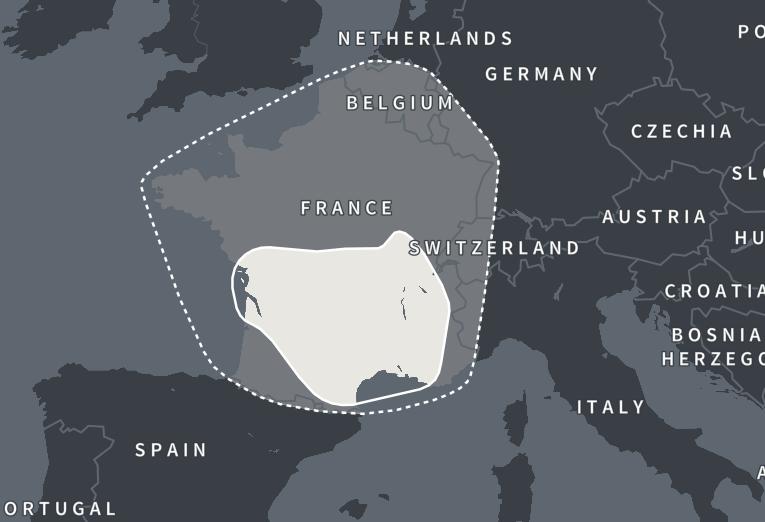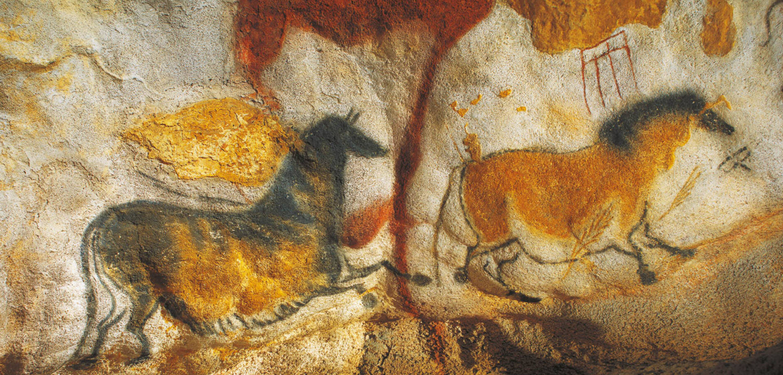What is France DNA Ethnicity on Ancestry?
The results of our AncestryDNA tests may sometimes be what we expect or on occasion may be a big surprise. Either way, often we need a little more information regarding some of the regions that arise in our ethnicity estimates.

One region that is not at all uncommon is the France DNA region. Those who still live in this region already understand all about its history and culture. There are others, however, who may never have even visited or in fact been aware that they have ancestors from that area.
In this post we will go into more detail with regards to the history, geography and culture of the France region. We will also discuss what it means to be from this region and how easy or difficult it might be to trace our roots in the France Region.
What Is the France DNA Region?
As the name France DNA region suggests this region focuses mainly on the European country of France. It does however expand beyond the country of France itself into several neighboring nations which include:
- Belgium
- Luxembourg
- Germany
- Liechtenstein
- Switzerland
- Italy
- Monaco
- Spain
- Andorra

France DNA Region Subregions
There are essentially two regions in the France DNA region: a broad one that covers the entirety of France and several of its surrounding neighbors and a small one also referred to as France which focuses on Central and Southern France.
This smaller sub-region spans an area that includes Poitiers, Lyon, Bordeaux, Marseille and Grenoble. Those who have DNA from this area of the France ethnicity region would likely be able to trace their descent to there at some point in history.
France Region History
Prehistory of the France Region
Evidence of archaic humans in what we know as the France region dates back around 1.8 million years. It is known that Neanderthals were present in the region during the Upper Paleolithic but would be gradually replaced by Homo Sapiens around 35,000 BC.
There are regions in France that have examples of prehistoric cave art such as the Dordogne and Pyrenees. The art dates back to around 18,000 BC. As is often the case with cave art it depicts the things the humans were seeing and in many cases hunting. They were mainly hunter-gatherers at this point.

As the last Glacial period came to end the climate became milder across Western Europe. This allowed the human population in the region of France to become more sedentary starting around 7,000 BC. Over time and especially between the 4th and 3rd Millennium BC agriculture started to develop at pace. This was followed by advances in metallurgy during the late 3rd millennia BC.
France's First City
The first city to develop in France did not come from the local populace but instead from invaders from Greece. Coming from the west coast of Anatolia this group settled a city called Massalia near modern day Marseille.
Gallic Celts
While the Greeks were arriving in the south, Gallic Celts from western Europe started to encroach in the east of France. During the 5th and 3rd centuries BC these tribes began to move deeper into the region. The combination of these new visitors and the local population led to what would become known as the Gaul region. This would range between the Rhine, the Atlantic Ocean, the Pyrenees and Mediterranean.
A prosperous country Gaul would thrive but would be subject to heavy influence in the south from not only the Greeks but also the Romans. The Gaul’s however did not just sit and allow this because around 390 BC a Gallic chieftain called Brennus led his troops to Italy through the Alps. He would defeat the Romans at the battle of the Allia and actually besieged and ransomed Rome itself.
This would lead to centuries of conflict between the Gauls and the Romans. Ultimately the Romans would conquer parts of Gaul around 125 BC renaming it Provincia Nostra (Our Province). This over time would evolve into the region we know today as Provence. Julius Caesar would complete the conquest of Gaul by 52 BC. Over time the Gauls would mix with the Roman settlers and adopt their general culture.
The Barbarians
After hundreds of years of settled Roman society a new threat arrived between 250 – 280 AD. Referred to as Barbarians these were tribal groups from Western Europe who had not succumbed to the Roman Empire.
This would settle down by the 4th century and this would also coincide with the Roman emperor Constantine I converting to Christianity. This would lead to a mass spread of the religion throughout the empire.

During the 5th century the Barbarians returned, Teutonic tribes invaded the region from what is known today as Germany, the Visigoths would settle in the southwest, the Burgundians settled along the Rhine River Valley, and the Franks would settle in the north. It is actually from this Frankish Germanic tribe that the region eventually got the name France.
The Franks
As the Antiquity period came to an end France was a divided nation shared between the Germanic Barbarian tribes and a small Gallo-Roman region known as the Kingdom of Syagrius. Around this time Celts from Britain would arrive in the north fleeing from the Anglo-Saxon settlement of their home region.
They settled on the Armorica Peninsula which would be renamed Brittany. In this region Celtic Culture held on and a number of small kingdoms arose.
The Franks who were also settled in the north really started to thrive during the late 5th century. Their first king Clovis I declared himself monarch around 481 AD and would route the remaining Roman governors and their forces in the region by 486 AD.
Clovis I went on to challenge his neighbors the Visigoths proclaiming he would become Christian if he succeeded in defeating them. The king did beat the Visigoths and in 508 AD converted to Christianity. At the same time he declared himself master of what is now Western Germany.
Not only did Clovis become Christian he also became Catholic which earned France the distinction of being called the “Eldest daughter of the church” by the papacy. This would ensure successive French Kings would be known as Rex Christianissimus (The Most Christian Kings of France).
The Frankish spread deep into Germanic lands establishing an empire further east of the borders of modern day France. This empire would thrive for centuries with the support of Rome and the Catholic church.
The Vikings
The scourge of Europe, the Vikings started to pose a threat to Francia as it was then known around the 9th and 10th centuries. This was a period in France where the power of the King was under threat internally from their own noblemen.
Some of these noblemen amassed such power that they could rival the monarch. This was the case with William the Conqueror. William was a French Duke but when he invaded England he became a monarch in his own right. This placed him as an equal with the King of France and this would cause tensions.
William the Conqueror of course was a descendant of the Viking ruler Rollo who took control of the Normandy region.
The French People's Today
Combined in the DNA found in the France region today you would likely find influences from the Celts, Germanic tribes, Scandinavians, Greeks and Italy. Those with deep roots in the region may find very varied results.
Years of invasions and war have crafted a unique DNA that helps you pinpoint this region as an ancestral one for millions of peoples around the globe. A swath of northwestern Europe may also find it has at least some occurrence of this DNA as borders expanded and retracted over thousands of years.
How Did You Get France Region DNA?
If you already know that you had family who came from France or any of the bordering European states then you know why you have France region DNA. If this result came as a surprise you may not know how exactly you came by DNA from this region.

If you have a sizable percentage of DNA from this region then it is likely you have an ancestor who was born in or close to the country of France.
Is the Result Accurate?
When it comes to ethnicity estimates the higher the percentage you have from a certain region the more likely it is to be accurate. If your percentage is low, however, then it is harder to pinpoint exactly where your most recent ancestors came from.
A low result could mean a distant ancestor from that region. It is best to focus on your highest rated region's matches to determine where your ancestors came from more recently. A low percentage can often be hard to locate because the ancestor in question could be many generations back in your tree.
How to Research my Ancestry from These Regions
The results of a DNA ethnicity test are of course a great place to start especially if there is an unexpected result found in the report. As always of course the DNA cannot tell the whole story and we need to actually do the research work.
A percentage on an ethnicity estimate means very little unless you follow through and start building up your family tree. The relevant ancestors may be several generations back and it may take a lot of research to discover who they were.
If you have specific regions mentioned in your report then you have a good idea of where your ancestor may have originated from. Ancestry DNA even has migratory information from some of these regions through to the final settlement places in the United States or elsewhere in the world.
Using Ancestry you may be able to determine not only who your ancestors were from the British Isles but perhaps the reason they decided to move.
French Migration
Between 1820 – 1970 somewhere around 730,000 French immigrants made their way to the United States. This was just a small fraction of the 35.7 million European immigrants into the US during this time period.

There had however been some more small-scale immigration prior to this point prior to the nation gaining its independence. In total 23 of the contiguous United States were colonized at least in part by French pioneers or French Canadians.
Final Thoughts
The France DNA region on AncestryDNA covers an area that has seen millions of years of humanoid habitation. Early homo sapiens lived there tens of thousands of years ago and DNA from these early peoples likely still runs in the veins of the modern day populace.
Over the millennia outside influences have come from the north, south and east in the form of Germanic tribes, Greeks, Romans, Barbarians and Vikings. This has helped create a unique pool of DNA that can be traced to the region.
To possess DNA from this region is to be part of a history that has seen conflict and the influences of ancient empires.
Link To or Reference This Page
We spent a lot of time downloading, cleaning, merging, and formatting the data that is shown on the site.
If you found the data or information on this page useful in your research, please use the tool below to properly cite or reference Name Census as the source. We appreciate your support!
-
<a href="https://namecensus.com/blog/what-is-france-dna-ethnicity-on-ancestry/">What is France DNA Ethnicity on Ancestry?</a>
-
"What is France DNA Ethnicity on Ancestry?". NameCensus.com. Accessed on May 4, 2024. https://namecensus.com/blog/what-is-france-dna-ethnicity-on-ancestry/.
-
"What is France DNA Ethnicity on Ancestry?". NameCensus.com, https://namecensus.com/blog/what-is-france-dna-ethnicity-on-ancestry/. Accessed 4 May, 2024
-
What is France DNA Ethnicity on Ancestry?. NameCensus.com. Retrieved from https://namecensus.com/blog/what-is-france-dna-ethnicity-on-ancestry/.
